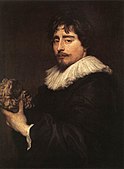Oldmasters Museum
 The Oldmasters Museum's entrance on the Rue de la Régence/Regentschapsstraat | |
 Interactive fullscreen map | |
Former name | |
|---|---|
| Location | Rue de la Régence / Regentschapsstraat 3, 1000 City of Brussels, Brussels-Capital Region, Belgium |
| Coordinates | 50°50′31″N 4°21′28″E / 50.84194°N 4.35778°E |
| Type | Art museum |
| Public transit access |
|
| Website | Official website |
The Oldmasters Museum (French: Musée Oldmasters; Dutch: Oldmasters Museum) is an art museum in the Royal Quarter of Brussels, Belgium, dedicated to Old master European painters from the 15th to the 18th centuries. It is one of the constituent museums of the Royal Museums of Fine Arts of Belgium.
The museum was founded in 1801 by Napoleon.[1] It was formerly called the Royal Museum of Ancient Art (French: Musée royal d'art ancien; Dutch: Koninklijk Museum voor Oude Kunst). It is housed in the main building of the Royal Museums of Fine Arts (Palace for Fine Arts) located at 3, rue de la Régence/Regentschapsstraat. This site is served by the tram stop Royale/Koning (on lines 92 and 93).[2][3]
Building
[edit]The main building that now houses the Oldmasters Museum was built as the Palace for Fine Arts (French: Palais des Beaux-Arts, Dutch: Paleis voor Schone Kunsten) (not to be confused with the current Centre for Fine Arts). It was designed by the architect Alphonse Balat and funded by King Leopold II. Balat was the king's principal architect, and the building was one part of the king's vast construction projects for Belgium. The building was completed in 1887, and stands as an example of the Beaux-Arts architecture use of themed statuary to assert the identity and meaning of the building.[4]

The building's extensive programme of architectural sculpture includes four allegorical figures, symbolising Music, Architecture, Sculpture, and Painting, atop the four main piers, the work of sculptors Égide Mélot, Joseph Geefs, Louis Samain, and Guillaume de Groot respectively. The gilded finial, Genius of Art, was also designed by de Groot. The three rondels representing Rubens, Van Ruysbroek, and Jean de Bologne, symbolising Painting, Architecture, and Sculpture respectively, are the work of Antoine van Rasbourg, Antoine-Félix Bouré and Jean Cuypers. The two bas-relief panels symbolise Music by Thomas Vincotte, and Industrial Arts by Charles Brunin. The two bronze groups on pedestals represent The Crowning of Art by Paul de Vigne, and The Teaching of Art by Charles van der Stappen.[5]
On the side of the building, a memorial commemorates five members of the National Royalist Movement, a resistance group killed during the liberation of Brussels on 3–4 September 1944.[6] Alongside the building's western face is a sculpture park, with works by Aristide Maillol, Emilio Greco, Paul Hanrez and Bernhard Heiliger.
Collection
[edit]The museum's collection includes works by several Early Netherlandish painters, including Robert Campin, Rogier van der Weyden, Petrus Christus, Dirk Bouts, Hans Memling, Hieronymus Bosch, Gerard David, and Lucas Cranach the Elder.[1] Other painters represented in the collection include Pieter Bruegel the Elder, Joos de Momper, Frans Snyders, Philippe de Champaigne, Peter Paul Rubens, Simon Vouet, Jusepe de Ribera, Jacques Jordaens, Anthony van Dyck, and Giovanni Battista Tiepolo.[1]
For English-speakers, the Landscape with the Fall of Icarus, by or after Bruegel, is one of the most famous works, if only because of W. H. Auden's poem Musée des Beaux Arts, the museum's name at the time. The Death of Marat by Jacques-Louis David is an iconic work, and Gustaf Wappers' huge Episode of the Belgian Revolution of 1830, painted very soon after the event, is a famous evocation of it.
-
Philip the Fair and Joan the Mad in the gardens of the castle of Brussels, Master of Affligem, 1495–1506
-
By or after Pieter Bruegel the Elder, Landscape with the Fall of Icarus
-
Assumption of the Virgin Mary, Peter Paul Rubens, c. 1616
-
Portrait of the Sculptor Duquesnoy, Anthony van Dyck, 1622
-
Episode of the Belgian Revolution of 1830, Gustaf Wappers, 1834
See also
[edit]- List of museums in Brussels
- History of Brussels
- Culture of Belgium
- Belgium in the long nineteenth century
References
[edit]Citations
[edit]- ^ a b c "Musée Oldmasters Museum". Royal Museums of Fine Arts of Belgium. Retrieved 26 May 2016.
- ^ "Ligne 92 vers SCHAERBEEK GARE - stib.be". www.stib-mivb.be. Retrieved 17 December 2023.
- ^ "Ligne 93 vers STADE - stib.be". www.stib-mivb.be. Retrieved 17 December 2023.
- ^ Fine-arts-museum.be accessed 9/1/10
- ^ Franc̜oise Roberts-Jones, Chronique d'un musée: Musées royaux des beaux-arts de Belgique (in French), Brussels, p. 41
- ^ "Monument: National Royalists Monument". Brussels Remembers. Archived from the original on 19 April 2013.
Bibliography
[edit]- Van Kalck, Michèle (2003). De Koninklijke Musea voor Schone Kunsten van België : Twee eeuwen geschiedenis (in Dutch). Vol. 2. Tielt: Lannoo. ISBN 978-9-02095-184-4.
- Le Patrimoine monumental de la Belgique: Bruxelles (PDF) (in French). Vol. 1C: Pentagone N-Z. Liège: Pierre Mardaga. 1994. pp. 172–176.
External links
[edit] Media related to Old Masters Museum at Wikimedia Commons
Media related to Old Masters Museum at Wikimedia Commons- Official website







